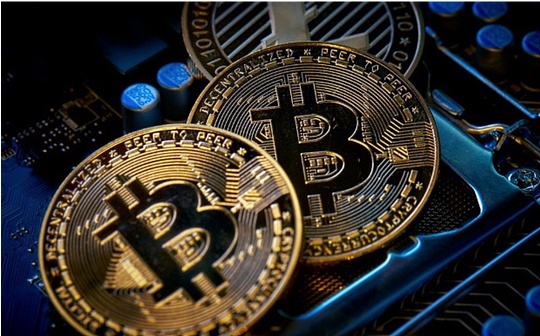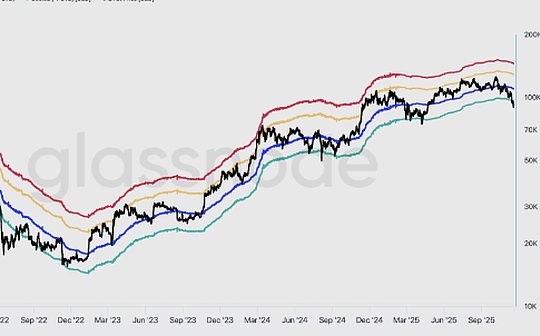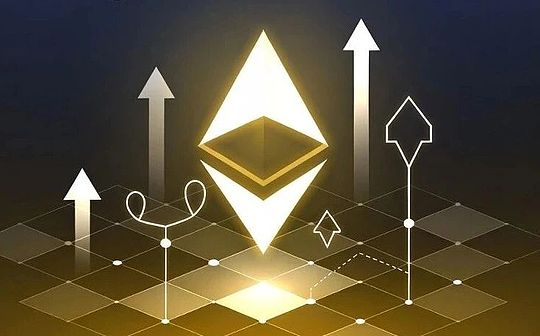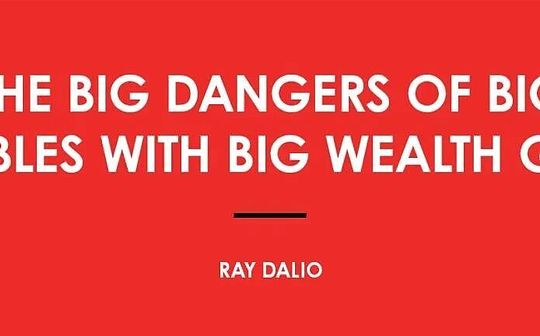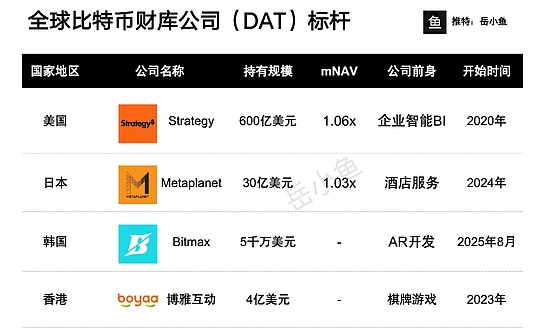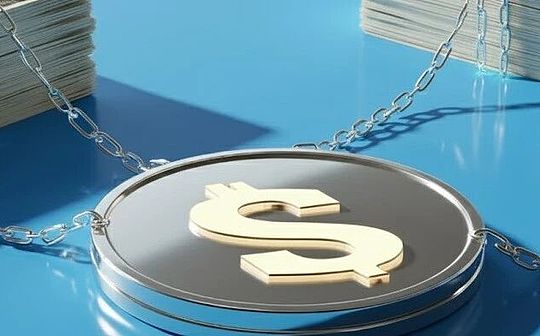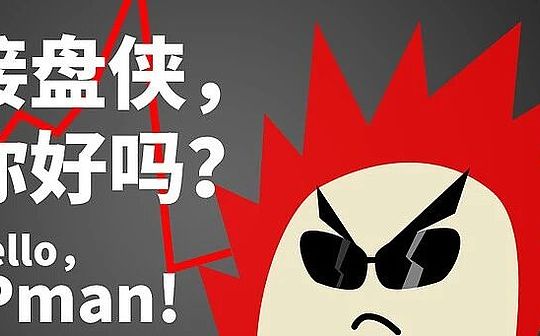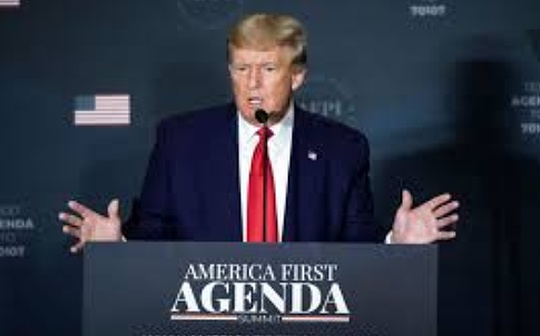
Original title:Black or White?
Author: Arthur Hayes, founder of BitMEX; compiled by: 0xjs@Bitchain Vision
When asked about his pragmatic attitude towards implementing the economic system in China, former Chinese leader Deng Xiaoping once said this famous saying: “No matter whether it is black or white, catching a mouse is a good cat.”
If you’ve ever heard Kamala Harris speak without using a teleprompter, you know what I’m talking about.There is a similar sophistry on the land of “freedom,” pickup trucks and Doritos corn crisps.I want to express my opinion on a plastic economic “ism” in a peaceful economic system under the United States.I will refer to the current policies implemented by Trump fans and newly elected President Trump as American capitalism with Chinese characteristics.
The elites who ruled the peace under the United States did not care whether the economic system was capitalist, socialist or fascist, but whether the policies implemented helped them retain their power.The United States was no longer a purely capitalist state in the early 19th century.Capitalism means that the rich will lose money if they make a wrong decision.This was banned as early as 1913 when the U.S. Federal Reserve was founded.As the benefits of privatization and socialization losses have an impact on the state and create extreme class divisions between the numerous pathetic or nasty people living in the inland and the upright, respectable, sophisticated coastal elites, President Franklin Roosevelt mustCorrect the route and distribute some bread crumbs to the poor through his New Deal policy.At that time, like now, expanding government relief to laggards was not a policy welcomed by wealthy so-called capitalists.
The pendulum swung back from extreme socialism (in 1944, the highest marginal tax rate for those earning more than $200,000 to 94%) to unrestrained corporate socialism that began in the 1980s Reagan era.Since then, the neoliberal economic policy of the central bank printing money sent money to the financial services industry, hoping that wealth would trickle down from top to bottom. This policy is the current situation before the outbreak of the new crown epidemic in 2020.President Trump responded to the crisis by guiding his inner Roosevelt New Deal; he gave everyone the most money since the New Deal.From 2020 to 2021, the United States printed 40% of the total existing dollar amount.Trump began a stimulus check party, and President Biden continued the popular alms during his tenure.In evaluating the impact on government balance sheets, something strange happened between 2008 and 2020 and 2022.

From 2009 to 2020, the peak of trickle-drop economics, whose funds come from central bank money printing and euphemistically called quantitative easing (QE).As you can see, the economy (nominal GDP) is growing at a lower rate than debt accumulation at the country level.In other words, the rich spend the government’s windfall on their assets.These types of transactions have not generated any actual economic activity.As a result, the issuance of trillions of dollars in debt funds to wealthy financial asset holders increases the debt-to-nominal GDP ratio.
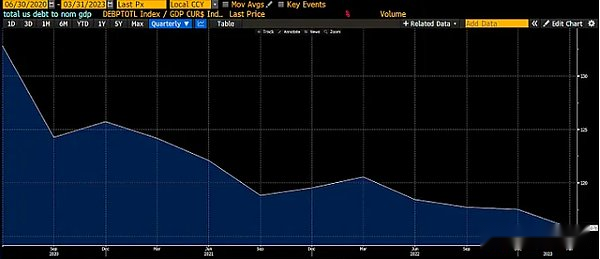
From the second quarter of 2020 to the first quarter of 2023, Presidents Trump and President Biden went against the trend.Their Treasury Department issued bonds, which the Fed purchased in printed dollars (QE), but instead of sending the bonds to the rich, the Treasury Department mailed the checks to everyone.The poor have real cash in their bank accounts.Apparently, JPMorgan CEO Jamie Dimon received a share of transaction fees transferred by the government… He is Li Ka-shing of the United States; you can’t escape paying this old guy.The poor are poor because they spend all their money on goods and services, and that’s exactly what they did during this period.As the speed of currency circulation far exceeds 1, economic growth is booming.That is, a $1 debt creates more than $1 in economic activity.So, magically, the ratio of U.S. debt to nominal GDP has dropped.
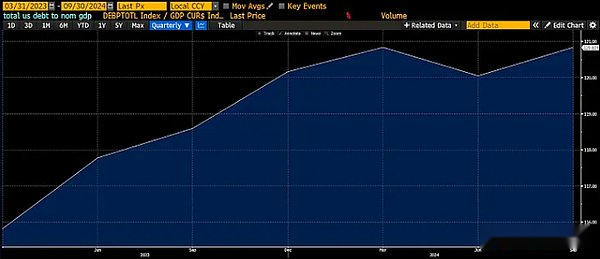
Inflation is raging because the supply of goods and services is growing at a rate that cannot keep up with the growth of purchasing power of people through government debt financing.Rich people with government bonds are not satisfied with these populist policies.These wealthy people holding bonds suffered the worst overall rate of return since 1812.The rich sent their prince charming, Fed Chairman Jay Powell to fight back.He started hikes in early 2022 to control inflation, and while Volkswagen had hoped for another round of stimulus, such policies were banned.U.S. Treasury Secretary Bad Gurl Yellen stepped in to eliminate the impact of the Fed’s attempt to tighten monetary conditions.She exhausted the Fed’s reverse repurchase tool (RRP) by shifting debt issuance from the long end (coupon) to the short end (notes).This provided nearly $2.5 trillion in fiscal stimulus, mainly benefiting the wealthy who held financial assets since September 2002; the asset market has flourished as a result.As after 2008, these governments’ generous aid did not generate any real economic activity, and the ratio of U.S. debt to nominal GDP began to rise again.
Has Trump’s new cabinet learned the correct lessons from the recent economic history of the US rule?I believe yes.
Most people believe that Scott Bassett will be elected by Trump to replace Yellen as U.S. Treasury Secretary, who has delivered several speeches on how to “repair” the United States.His speeches and columns detail how to implement Trump’s “America First” program, the plan is quite similar to China’s development plan (started in Deng Xiaoping in the 1980s and has continued to this day).The program aims to boost nominal GDP by providing government tax credits and subsidies to drive the return of key industries (shipping, semiconductor factories, automobile manufacturing, etc.).Companies that qualify will receive cheap bank financing.Banks will once again scramble to provide loans to real companies because their profitability is guaranteed by the U.S. government.As companies expand within the U.S., they have to hire American workers.A higher-paying job for the average American means more consumption expenditure.If Trump restricts the number of immigrants who cross the border from the “defer pit country” wearing straw hats, eating cats and dogs, dark skin, and dirty, the impact will be further amplified.These measures stimulate economic activity, and the government obtains funds through corporate profits and wage income taxes.The government deficit must remain large to fund these projects, and the Ministry of Finance provides funds to the government by selling bonds to banks.Banks can now readjust their balance sheets as the Federal Reserve or legislators suspended supplemental leverage.Winners are ordinary workers, companies that produce “approved” products and services, and the U.S. government whose debt to nominal GDP ratio has declined.This is a reinforced quantitative easing policy for the poor.
Wow, it sounds good.Who would object to such a magical prosperity in America?
Losers are those who hold long-term bonds or savings deposits.This is because the yields of these tools will be intentionally controlled below the nominal growth rate of the U.S. economy.If wages cannot keep up with higher inflation levels, people will also suffer.If you haven’t noticed it yet, joining a union is getting cool again.4 and 40 are new slogans.That is, over 40% of the wages will be paid to workers over the next 4 years, i.e. a 10% increase in annual salary to continue working.
Don’t worry for readers who think they are rich.Here is a cheat sheet about what to buy.This is not financial advice; I am just sharing my management of my portfolio.Read it and buy stocks in these verticals every time a bill passes and funds are issued to approved industries.Instead of saving with fiat bonds or bank deposits, buy gold (the financial suppression hedge for baby boomers) or Bitcoin (the financial suppression hedge for millennials).
Apparently, the hierarchy of my portfolio starts with Bitcoin, then other cryptocurrencies and crypto-related corporate equity, then gold stored in the vault, and finally stonks.I would keep a small amount of dirty fiat in money market funds to pay my American Express bill.
I will use the rest of this article to explain how quantitative easing policies for the rich and poor affect economic growth and money supply.I will then predict how the exemption from banks’ supplementary leverage ratio (SLR) will once again create the ability to carry out unlimited quantitative easing for the poor.In the last part, I will launch a new index to track the supply of US bank credit and show how Bitcoin outperforms all other assets when it is subject to bank credit supply shrinkage.
Money Supply
I have to do with Zoltan Pozar’sEx Uno Plures PapersThe quality is extremely admirable.A long weekend in the Maldives recently, I read all the articles he wrote between surfing, Iyengar yoga and myofascial massage.His work will occupy an important position in the rest of this article.
I will publish a series of hypothetical accounting books.To the left of T is the asset.On the right side of T is the liability.A blue entry indicates an increase in value, and a red entry indicates a decrease in value.
The first example focuses on how the Fed’s purchase of bonds through quantitative easing affects money supply and economic growth.Of course, this example and the rest of the following would be a little silly to make it fun and engaging.
Imagine you were Powell during the US regional banking crisis in March 2023.To vent, Powell heads to the tennis club at 370 Parker Avenue in New York City to play squash with his other million-dollar financial partner.Powell’s friend was furious.
This friend, we call him Kevin, is a grumpy financier who said, “Jay, I have to sell my Hampton house. I put all my money in Signature Bank, obviously INot eligible for federal deposit insurance because my balance is out of limit. You have to do something. You know what Bonnie would look like when he had to stay in town for a day in the summer. She was so unbearable.”
Jay responded: “Don’t worry, I know what you mean. I’m going to implement a $2 trillion quantitative easing policy. It will be announced Sunday night. You know the Fed always supports you. Without your contribution, who knowsWhat would America be like? Imagine if Donald Trump had to regain power because of Biden’s tenure in office. I remember Trump snatching my chick at Dorsia in the early 1980s, fuckthat guy.”
The Fed has formulated a regular bank financing plan, which is aimed at solving the banking crisis, unlike direct quantitative easing.But please allow me to play some artistic freedom here.Now, let’s see what impact the $2 trillion quantitative easing will have on the money supply.All numbers will be in billions of dollars.

1. The Federal Reserve purchases $2,000 in U.S. Treasury bonds from BlackRock and pays them with reserves.JPMorgan performs its banking duties by facilitating such swaps.JPMorgan received $2,000 in reserves and deposited $2,000 in BlackRock.The Fed’s quantitative easing led to banks creating deposits that eventually turned into currency.
2. BlackRock has now lost U.S. Treasury bonds and must lend the money to others, that is, acquire another interest-bearing asset.BlackRock CEO Larry Fink doesn’t hang out with the poor.He works only with industry leaders.But now, he is immersed in the field of technology.There is a new social networking loot app that is building a community where users share plump photos.It is called Anaconda.Their tagline is “My anaconda doesn’t want anything unless you have a butt, dear.” Anaconda is in its growth stage and BlackRock is happy to buy $2,000 in bonds.
3. Anaconda is the backbone of American capitalism.They conquered the market by indulging the male population aged 18-45 years old in their apps.As they stopped reading and began browsing the web, the productivity of this group has declined.Anaconda funded share buybacks by issuing debt, thus enabling tax optimization so that they do not have to remit retention gains abroad.Reducing the number of stocks not only increases the share price, but also increases their earnings because even if their earnings are not growing per share, their earnings will increase due to the lower denominator.As a result, passive index investors like Blackrock are more likely to buy their stocks.The result is that after the nobles sold their stocks, they had $2,000 in their bank deposits.
4. Anaconda Rich shareholders did not use the money they received immediately.Gagosian (note: founder of the famous gallery) held a grand party at the Art Basel Miami.Despite all the stuff screwed up, the financial aristocrats decided to buy the latest canvas graffiti to enhance their qualifications as serious art collectors and impress the bad guys on the stalls.The sellers of artwork belong to the same class as their economic class.The net effect of sponsoring “artwork” is that the seller’s bank account is deducted and the buyer’s account is credited.
After all these transactions, no real economic activity was generated.The Fed injects $2 trillion in printed currency into the economy, all it does is to increase bank deposits for the rich.Even a U.S. company’s financing didn’t bring any growth, as the funds were used to drive up the stock price and create zero jobs.Quantitative easing of USD 1 led to an increase in the money supply by USD 1, resulting in economic activity of USD 0.This is not a good use for debt.Therefore, the ratio of debt to nominal GDP for the rich increased during the period of quantitative easing from 2008 to 2020.
Now, let’s take a look at President Trump’s decision-making process during the COVID-19 pandemic.Recall March 2020: The COVID-19 pandemic has just begun and Trump’s advisers instructed him to “flatten the curve” (remember that nonsense?).He was advised to shut down the economy and allow only “necessary workers” (remember them, poor people who deliver goods to you at a lower minimum wage?) to continue working.
Trump: “Damn it, just because some quacks think the flu is real, do I need to shut down the economy?”
Advisor: “Yes, Mr. President. I should remind you that the complications caused by COVID-19 infection are mainly obese baby boomers like you. I should also add that if people over 65 get sickAnd it will require hospitalization, and treating people over the age of 65 will cost a lot. You need to block all non-essential staff.”
Trump: “It will cause an economic collapse, let’s give everyone a check so they don’t complain. The Fed can buy debt issued by the Treasury Department to fund those issuances.”
Using the same accounting framework, let’s take a step-by-step look at how quantitative easing can help the poor.

1. Like the first example, the Fed conducts quantitative easing by using reserves to buy $2,000 in Treasury bonds from BlackRock.
2. Unlike the first example, the Ministry of Finance participated in the flow of funds.To pay for Trump’s stimulus checks, the government must borrow money by issuing government bonds.BlackRock bought government bonds rather than corporate bonds.JPMorgan Chase helped BlackRock convert its bank deposits into reserves held by the Federal Reserve, which can be used to purchase Treasury bonds.The Treasury Department receives deposits from the Federal Reserve in its Treasury General Account (TGA), similar to a checking account.
3. The Ministry of Finance sends stimulus plans to everyone, mainly to the vast majority of ordinary people.This has resulted in a shrinking TGA balance, while the Fed held a corresponding increase in reserves that became civilians’ deposits at JPMorgan Chase Bank.
4. Civilians are civilians, and they spend all the excitement on the new Ford F-150 pickup truck.Fuck electric cars, here is America, so they are all consuming that black gold.The civilian’s bank account was deducted, while Ford’s bank account was credited.
5. Ford does two things when selling these trucks.First, they pay workers’ wages and bank deposits are transferred from Ford account to regular workers’ accounts.Ford then goes to the bank to make a loan to increase production; as you can see, the issuance of the loan generates its own deposits from the recipient Ford and increases the money supply.Finally, the average worker wants to go on vacation and get personal loans from the bank, which is happy to offer given the strong economy and high-paying jobs.Ordinary bank loans create additional deposits, just like Ford borrows money.
6. The ending balance of deposits or funds is US$3,000.That’s $1,000 more than the $2,000 the Fed initially injected through quantitative easing.
From this example, quantitative easing for the poor stimulates economic growth.The Ministry of Finance issued stimulus measures to encourage civilians to buy trucks.Due to the demand for goods, Ford was able to pay employees and apply for loans to increase production.Employees with high-paying jobs are eligible for bank credit so that they can spend more.$1 debt generates more than $1 in economic activity.This is a good outcome for the government.
I would like to go further and discuss how banks provide unlimited financing to the Ministry of Finance.

We will start with step 3 above.
4. The Ministry of Finance is issuing a new round of stimulus plans.To raise funds, the Treasury auctioned bonds, which JPMorgan, as a primary dealer, used in reserves held by the Federal Reserve to purchase.The sale of bonds will increase the Treasury’s TGA balance at the Federal Reserve.
5. As in the previous example, the checks sent by the Treasury look like civilians’ deposits at JPMorgan.
When the Treasury issues bonds purchased by the banking system, it converts reserves held by the Federal Reserve that have no production effect on the economy into deposits held by civilians that can be used to purchase things and generate economic activity.
Let’s have another T-picture.What happens when the government implements industrial policies by committing to provide tax relief and subsidies to companies that produce the goods and services they need?

In this example, peace under the U.S. is exhausting the bullets they needed for gunfights in the Persian Gulf inspired by Clint Eastwood Western films.The government passed a bill that promised subsidies for bullet production.Smith Wesson applied for and obtained a contract to supply ammunition to the military.Smithwesson was unable to produce enough bullets to fulfill the contract, so they applied for a loan from JPMorgan to build a new factory.
1. After receiving the government contract, JPMorgan’s loan officers loaned Smithwesson with confidence.The lending behavior created $1,000 out of thin air.
2. SmithWeston built a factory and created wages for ordinary people, which eventually became JPMorgan’s deposits.The money created by JPMorgan has become the deposits for those who are most likely to consume, that is, ordinary people.I have already talked about how the consumption habits of ordinary people create economic activities.Let’s change this example a little bit.
3. The Treasury needs to subsidize Smithwesson by issuing new bonds of $1,000 at auction.JPMorgan attended the auction to buy bonds, but had no reserves to buy bonds.With the use of the Fed discount window no longer tainted any more, JPMorgan uses its Smith Wesson Corporate Bond Assets as collateral for Fed Reserve loans.These reserves are used to purchase newly issued Treasury bonds.The Treasury then paid a subsidy to Smithwesson, which became JPMorgan’s deposit.
This example shows how the U.S. government uses industrial policies to induce JPMorgan to issue loans and use the assets created by the loans as collateral to purchase additional U.S. Treasury bonds from the Federal Reserve.
constraint
It looks like the Treasury Department, the Fed and the Bank operate a magic money-making machine that can accomplish one or more of the following tasks:
1. They can inject financial assets into the rich, but they will not trigger any actual economic activity.
2. They can fill the bank accounts of the poor, who often use relief funds to purchase goods and services, resulting in real economic activity.
3. They can ensure the profitability of specific players in a specific industry.This allows businesses to expand using bank credit, resulting in actual economic activity.
Are there any restrictions?
Yes, banks cannot create unlimited amounts of money because they must provide expensive equity for every debt asset they hold.In professional terms, different types of assets have risk-weighted asset fees.Even so-called “risk-free” government bonds and central bank reserves can incur equity capital expenses.That’s why at some point, banks cannot meaningfully participate in bidding for U.S. Treasuries or issuing corporate loans.
There is a reason equity capital must be used for mortgages and other types of debt securities.If the borrower goes bankrupt, no matter whether it is the government or the company, someone will bear the losses.Given that banks decide to create currency to lend or buy government bonds for profit, it is fair to have their shareholders bear the losses.When the loss exceeds the bank’s equity capital, the bank will go bankrupt.When a bank goes bankrupt, depositors lose money, which is bad.However, from a systematic perspective, what is worse is that banks cannot continue to increase credit in the economy.Given that some statutory financial systems require stable credit issuance to survive, bank failures may cause the entire house of cards to collapse.Remember – one player’s assets are another player’s liability.
When bank equity credit runs out, the only way to save the system is to create new fiat currencies and convert them into negative assets of the bank.Imagine Signature Bank lending only to Su Zhu and Kyle Davies, the now-disbanded Three Arrows Capital (3AC).Su and Kyle gave the bank a false balance sheet that misrepresented the company’s health.They then take cash from the fund and hand it over to their wives in the hope that it will be spared from bankruptcy, and when the fund goes bankrupt, the bank has nothing to seize and the loan is worth zero.It’s fiction; Su and Kyle are good people.They will never do what I described ;).Signature has provided a large number of campaign donations to Elizabeth Warren, a member of the U.S. Senate Banking Committee.Using their political influence, Signature convinces Senator Warren that they deserve to be saved.Senator Warren called Powell and told him that the Fed must convert the dollar to 3AC debt at face value through the discount window.The Fed did as required, Signature was able to convert 3AC bonds into new dollar bills, and banks were able to bear any deposit outflows.Again, this didn’t really happen; it was just an example of “stupid”.But the moral of this story is that if the bank does not take out enough equity, the entire population will eventually pay for it due to the depreciation of the currency.
Maybe my hypothesis example makes some sense; this isStraits TimesA recent report:
The wife of Zhu Su, co-founder of bankrupt cryptocurrency hedge fund Three Arrow Capital (3AC), succeeded in selling a building she owned in Singapore for $51 million despite some of the couple’s other assets frozen by the court.Luxury house.
Back to reality.
Suppose the government wants to create unlimited amounts of bank credit.In this case, they must change the rules to make Treasury and certain types of “approved” corporate debt (can be divided by type, such as investment grade bonds, or by industry, such as debt issued by semiconductor companies) is protected from the so-called supplementary leverage ratio (SLR).
If U.S. Treasuries, central bank reserves and/or approved corporate debt securities are not subject to SLR, banks can purchase unlimited amounts of debt without any expensive equity burden.The Fed has the right to grant exemptions.They did that from April 2020 to March 2021.If you remember, the U.S. credit market was in a stagnation.The Fed needs to get banks to lend to the U.S. government again by participating in Treasury auctions, as the government is about to launch a trillion-dollar stimulus package without taxes to pay.The exemption is very effective.This has led to banks buying a large number of U.S. Treasuries.The downside is that the same U.S. Treasury prices fell sharply after Powell raised interest rates from 0% to 5%, triggering a regional banking crisis in March 2023.There is no free lunch in the world.
Bank reserve levels also limit the banking industry’s willingness to buy U.S. Treasury bonds at auctions.When banks feel that their reserves at the Fed reach the minimum comfort reserve level (LCLoR), they will stop participating in the auction.You don’t know until afterwards what the LCLoR is.
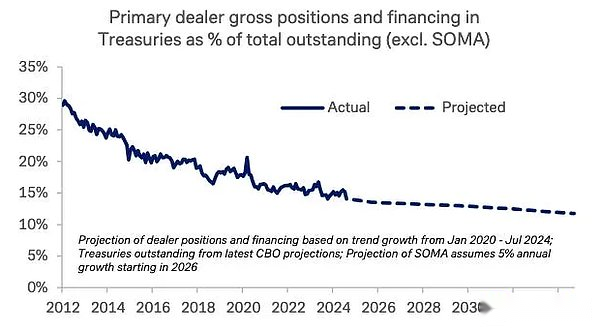
This is a chart from the Treasury Market Financial Resilience presentation released by the Treasury Borrowing Advisory Committee (TBAC) on October 29, 2024.This chart shows that the banking system holds smaller and smaller Treasury bonds, thus approaching LCLoR.This is a problem because marginal buyers in the Treasury market turn into capricious bond trading hedge funds as the Federal Reserve sells (QT) and central banks of surplus countries sell (or stop investing) their net export gains (de-dollarization)..
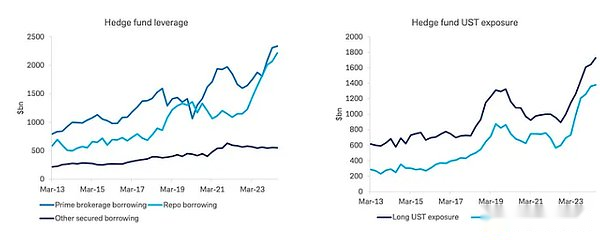
Here is another chart from the same presentation.As you can see, hedge funds are making up for the shortcomings.But hedge funds are not real money buyers.They are conducting arbitrage transactions, i.e. buying cheap spot treasury bonds and shorting treasury bond futures contracts.The cash part of the transaction is financed by the repurchase market.Repurchase refers to the exchange of assets (treasury bonds) into cash at a certain interest rate within a certain period of time.The repurchase market pricing of overnight financing using Treasury bonds as collateral is based on available commercial bank balance sheet amounts.As balance sheet capacity decreases, repurchase rates rise.If the cost of financing for Treasury bonds rises, hedge funds can only buy more Treasury bonds when prices fall relative to futures prices.This ultimately means that the price of auctioning Treasury bonds must fall and yields will rise.This is not what the Treasury wants to happen because it requires issuing more debt at increasingly cheaper prices.
Due to regulatory restrictions, banks cannot buy enough U.S. Treasury bonds, nor can they fund hedge funds to purchase U.S. Treasury bonds at affordable prices.That’s why the Fed must again exempt the bank from SLR.It improves liquidity in the Treasury market and allows for unlimited quantitative easing that can target the production part of the U.S. economy.
If you are unsure whether the Treasury and the Fed have learned the need for banking easing, TBAC clearly states what needs to be done in the page 29 slide of the same presentation:

Tracking numbers
If Trump economics works as I just mentioned, then we have to focus on the amount of bank credit growth we expect to see.Based on the above example, we know that quantitative easing for the rich is achieved by increasing bank reserves, while quantitative easing for the poor is achieved by increasing bank deposits.Thankfully, the Fed provides two data for the entire banking system every week.
I created a custom Bloomie index which is a combination of reserves and other deposits and liabilities <BANKUS U index>.
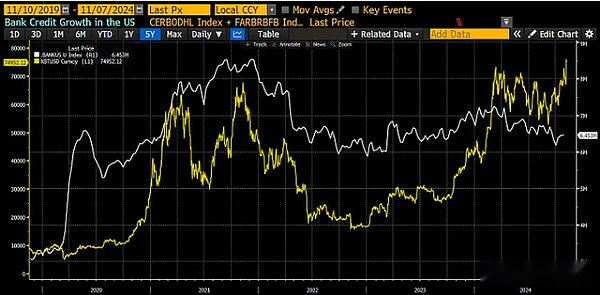
Here is my custom index for tracking US bank credit volume.In my opinion, this is the most important indicator of money supply.As you can see, sometimes it leads Bitcoin, like in 2020, and sometimes it lags behind Bitcoin, like in 2024.
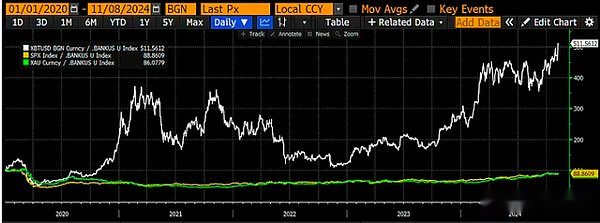
More importantly, however, how well an asset performs when it is subject to bank credit supply shrinkage.Bitcoin (white), S&P 500 (gold), and gold (green) are all divided by my bank credit index.The index of these values is 100, and as you can see, Bitcoin has performed outstandingly, up more than 400% since 2020.If you can only do one thing to fight the devaluation of fiat currencies, it is Bitcoin.You can’t argue with mathematics.
The way forward
Trump and his currency deputy have made it very clear that they will implement policies to weaken the dollar and provide the necessary funding for the return of U.S. industry.Given that the Republicans will control all three government departments over the next two years, they can pass through Trump’s entire economic plan without any effective opposition from the Democratic Party.Please note that I believe Democrats will join the money printing party because which politician can refuse to give free stuff to voters?
The Republican Party will first pass a bill that encourages manufacturers of key commodities and materials to expand domestic production.These bills will be similar to the Chip Act, Infrastructure Act and Green New Deal passed by the Biden administration.Bank credit growth will surge as businesses accept these government subsidies and receive loans.For those who claim to be stock selection experts, buy stocks of listed companies that produce what the government wants to make.
At some point, the Fed would give in, at least exempt the SLR burden of U.S. Treasury and central bank reserves.By then, the road to unlimited quantitative easing will be unobstructed.
The combination of legislative industrial policy and SLR exemptions will lead to a massive influx of bank credit.I have shown that such policies have a much higher rate of currency circulation than the traditional quantitative easing policy for the rich under the Federal Reserve regulation.Therefore, we can expect that Bitcoin and cryptocurrencies will perform as well, or even better, as they did from March 2020 to November 2021.The real question is, how much credit will be created?
The coronavirus stimulus package has injected about $4 trillion in credit.This incident will be even more serious.Defense and health care spending alone grows faster than nominal GDP.They will continue to grow rapidly as the United States increases its defense spending in response to the shift to a multipolar geopolitical environment.The percentage of people over the age of 65 will peak in 2030, meaning health care spending growth will accelerate from now until then.No politician can cut defense spending and health care, because if it is reduced, they will be elected to step down soon.All this means that the Treasury will be busy injecting a lot of debt into the market quarter after quarter to keep it running.I have previously shown how quantitative easing combined with Treasury borrowing can make money flow faster than 1.This deficit spending will increase the U.S. nominal growth potential.
When it comes to moving American businesses back home, the cost of achieving this goal will also reach trillions of dollars.Since China was allowed to join the World Trade Organization in 2001, the United States has voluntarily handed over its manufacturing base to China.In less than thirty years, China has become the world’s factory, producing the best quality products at the lowest prices.Even companies that want to move supply chains from China to so-called cheaper countries realize that the integration of so many suppliers along the eastern coast of China is so deep and effective that even Vietnam’s hourly wages are much lower, these companies still need to import intermediate parts from China to produce finished products.All in all, reorienting the supply chain to the United States will be a difficult task, and if it must be done for political expediency, it will be very expensive.What I’m talking about is,Cheap bank financing of high single digits to low double digits must be provided in order to transfer production capacity from China to the United States.
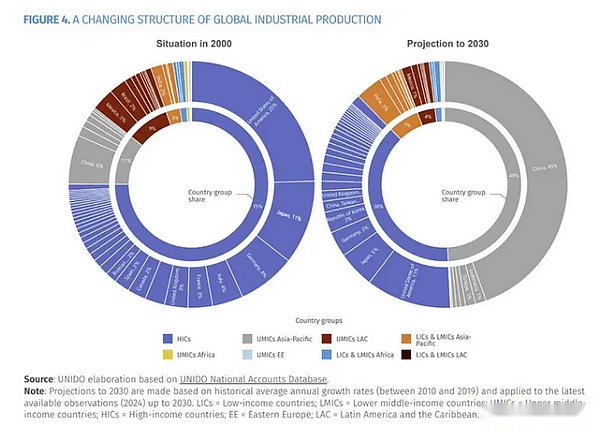 It took $4 trillion to reduce the debt-to-nominal GDP ratio from 132% to 115%.Suppose the United States further reduces it to 70%, which is the September 2008 level.Using linear extrapolation alone means that $10.5 trillion of credit must be created to achieve this deleveraging.
It took $4 trillion to reduce the debt-to-nominal GDP ratio from 132% to 115%.Suppose the United States further reduces it to 70%, which is the September 2008 level.Using linear extrapolation alone means that $10.5 trillion of credit must be created to achieve this deleveraging.
That’s why Bitcoin hit $1 million, because the price is set marginally.With the decline in the supply of free-trading Bitcoin, the most legal currency in history will chase havens not only from Americans, but from Chinese, Japanese and Western Europeans.Invest more and retain more and more.
If you doubt my analysis of the impact of quantitative easing on the poor, just read the economic history of China over the past thirty years, you will understand why I call the new economic system under the United States “American capitalism with Chinese characteristics””.

